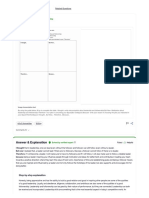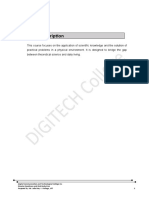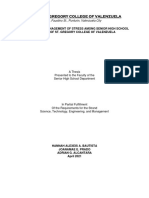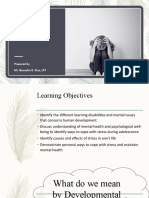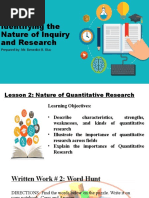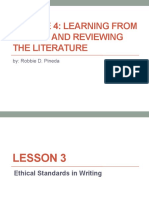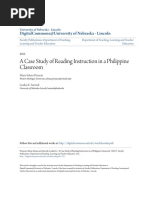0 ratings0% found this document useful (0 votes)
885 viewsLesson 5 - Practical Research
This document discusses different types of qualitative research methods including case studies, ethnography, phenomenology, content and discourse analysis, historical analysis, and grounded theory. It provides details on what each method involves such as long-term study of individuals or groups for case studies and examining language structures used in communication for discourse analysis. The document also lists advantages of qualitative research like adopting a naturalistic approach and understanding social interactions, and disadvantages including researcher subjectivity and the time-consuming nature of analysis.
Uploaded by
BenCopyright
© © All Rights Reserved
Available Formats
Download as PPTX, PDF, TXT or read online on Scribd
0 ratings0% found this document useful (0 votes)
885 viewsLesson 5 - Practical Research
This document discusses different types of qualitative research methods including case studies, ethnography, phenomenology, content and discourse analysis, historical analysis, and grounded theory. It provides details on what each method involves such as long-term study of individuals or groups for case studies and examining language structures used in communication for discourse analysis. The document also lists advantages of qualitative research like adopting a naturalistic approach and understanding social interactions, and disadvantages including researcher subjectivity and the time-consuming nature of analysis.
Uploaded by
BenCopyright
© © All Rights Reserved
Available Formats
Download as PPTX, PDF, TXT or read online on Scribd
You are on page 1/ 20
Making Words Meaningful
Pray constantly as if it was
an act of breathing and
eating.
Making Words Meaningful
Watering it daily will make
that tree yield fruits.
TYPES OF
QUALITATIVE
RESEARCH
1. CASE STUDY
It takes place in the field of
social care, nursing,
psychology, rehabilitation
centers , education, etc.
1. CASE STUDY
This involves a long time
study of a person, group,
organization, or situation. It
seeks to find answers to why
such thing occurs to the
subject.
1. CASE STUDY
Varieties of data collection
methods such as interviews,
questionnaires, observations
and documentary analysis
are used.
2. ETHNOGRAPHY
It is the study of a particular
cultural group to get a clear
understanding of its
organizational set-up,
internal operation and
lifestyle.
3. PHENOMENOLOGY
Coming from the word
“phenomenon,” which
means something known
through sensory experience.
3. PHENOMENOLOGY
It refers to the study of how
people find their experiences
meaningful. Its primary goal
is to make people
understand their
experiences.
4. CONTENT AND DISCOURSE
ANALYSIS
Content Analysis – requires an
analysis or examination of the
substance or content of the
mode of communication used by
a person, group, organization, or
any institution communicating.
4. CONTENT AND DISCOURSE
ANALYSIS
Discourse Analysis – study of
language structures used in the
medium of communication to
discover the effects of
sociological, cultural,
institutional, and ideological
factors on the content.
4. HISTORICAL ANALYSIS
It is the examination of
primary documents to make
you understand the
connection of past events to
the present time.
5. GROUNDED THEORY
It takes place when you
discover a new theory to
underlie your study at the
time of data collection and
analysis.
ADVANTAGES OR
STRENGTHS OF
QUALITATIVE
RESEARCH
1. Its adopt a naturalistic
approach to its subject
matter.
2. It promotes a full
understanding of human
behavior in their natural
setting.
3. It is instrumental for
positive changes.
4. It engenders respect for
people’s individuality
5. It is a way of
understanding & interpreting
social interactions
6. It increases the
researcher’s s interest in the
study.
7. It offers multiple ways of
acquiring and examining
knowledge about something.
DISADVANTAGES
OR WEAKNESSES
OF QUALITATIVE
RESEARCH
1. It involves a lot of
researcher’s subjectivity in
data analysis.
2. It is hard to know the
validity or reliability of the
data.
3. Its open-ended question
yield “data overload” that
requires long time analysis.
4. It is time-consuming.
5. It involves several
processes.
You might also like
- 0893 Lower Secondary Science Stage 7 Scheme of Work Tcm143 595695No ratings yet0893 Lower Secondary Science Stage 7 Scheme of Work Tcm143 595695105 pages
- Personal Development Midterm Reviewer Grade 11 - ABMNo ratings yetPersonal Development Midterm Reviewer Grade 11 - ABM7 pages
- Topic 9 The Study of Culture, Society, and Politics100% (1)Topic 9 The Study of Culture, Society, and Politics3 pages
- What Is Society? What Inspires Human Beings To Establish Societies?No ratings yetWhat Is Society? What Inspires Human Beings To Establish Societies?3 pages
- Antonio Molina: National Artist For MusicNo ratings yetAntonio Molina: National Artist For Music11 pages
- LESSON 2: The Meaning of Education, Types, Functions and Its Importance100% (1)LESSON 2: The Meaning of Education, Types, Functions and Its Importance4 pages
- Strongly Disagree Disagree Agree Strongly AgreeNo ratings yetStrongly Disagree Disagree Agree Strongly Agree2 pages
- LESSON 18: Leadership: Lessons On Leadership and Membership From FablesNo ratings yetLESSON 18: Leadership: Lessons On Leadership and Membership From Fables5 pages
- Learning Module in Ucsp Quarter 1 Week 1: Socioeconomic ClassNo ratings yetLearning Module in Ucsp Quarter 1 Week 1: Socioeconomic Class12 pages
- Understanding Culture, Society and PoliticsNo ratings yetUnderstanding Culture, Society and Politics5 pages
- Grade 12 Philosophy Reviewer - 1st SemesterNo ratings yetGrade 12 Philosophy Reviewer - 1st Semester5 pages
- Module 1 - Understanding Culture Society and Politics Through The Different Lenses of Social SciencesNo ratings yetModule 1 - Understanding Culture Society and Politics Through The Different Lenses of Social Sciences15 pages
- G11SLM2-21st-Century-Literature Q1 SHSPHNo ratings yetG11SLM2-21st-Century-Literature Q1 SHSPH19 pages
- Characteristics of Responsible Media User and ProducerNo ratings yetCharacteristics of Responsible Media User and Producer2 pages
- What I Have Learned: Activity 3 My Own Guide in Choosing A CareerNo ratings yetWhat I Have Learned: Activity 3 My Own Guide in Choosing A Career3 pages
- Philippine Politics and Governance Pointers 1No ratings yetPhilippine Politics and Governance Pointers 12 pages
- Ent112 Entrepreneurship 3rd Quarterly Assessment ReviewerNo ratings yetEnt112 Entrepreneurship 3rd Quarterly Assessment Reviewer15 pages
- 숤 Answered step-by-step: Answer & ExplanationNo ratings yet숤 Answered step-by-step: Answer & Explanation3 pages
- Mapeh: Music - Arts - Physical Education - Health100% (3)Mapeh: Music - Arts - Physical Education - Health15 pages
- Mercado, Aubrey M. (ABM205-KOTLER) MIL Activity #2No ratings yetMercado, Aubrey M. (ABM205-KOTLER) MIL Activity #21 page
- Directions: Read and Answer The Questions Below. Select The Letter of The Best Answer From Among The GivenNo ratings yetDirections: Read and Answer The Questions Below. Select The Letter of The Best Answer From Among The Given4 pages
- Lesson-5-Research-Types-of-Qualitative-ResearchNo ratings yetLesson-5-Research-Types-of-Qualitative-Research20 pages
- Identifying and Stating The Problem: Prepared by Mr. Benedict B. DiazNo ratings yetIdentifying and Stating The Problem: Prepared by Mr. Benedict B. Diaz37 pages
- Identifying The Nature of Inquiry and Research: Prepared By: Mr. Benedict B. DiazNo ratings yetIdentifying The Nature of Inquiry and Research: Prepared By: Mr. Benedict B. Diaz57 pages
- Identifying The Nature of Inquiry and Research: Prepared By: Mr. Benedict B. DiazNo ratings yetIdentifying The Nature of Inquiry and Research: Prepared By: Mr. Benedict B. Diaz46 pages
- Module 4: Learning From Others and Reviewing The Literature: By: Robbie D. PinedaNo ratings yetModule 4: Learning From Others and Reviewing The Literature: By: Robbie D. Pineda29 pages
- Harry Potter and The Voices of Our Actions: Prepared by Mr. Benedict B. Diaz0% (1)Harry Potter and The Voices of Our Actions: Prepared by Mr. Benedict B. Diaz42 pages
- Lesson 1 Introduction To Personal DevelopmentNo ratings yetLesson 1 Introduction To Personal Development25 pages
- Assessment by Case Studies and Scenarios: When To UseNo ratings yetAssessment by Case Studies and Scenarios: When To Use4 pages
- Insight Paper 3 - Journal - PRINT 1 PAGENo ratings yetInsight Paper 3 - Journal - PRINT 1 PAGE1 page
- A Case Study of Reading Instruction in A Philippine ClassroomNo ratings yetA Case Study of Reading Instruction in A Philippine Classroom13 pages
- Importance of Literature Review in Research100% (2)Importance of Literature Review in Research8 pages
- Activity 1 - Concept Linkers: 1.inherit What Is ItNo ratings yetActivity 1 - Concept Linkers: 1.inherit What Is It9 pages
- Katrien de Graeve and Valerie de Craene - The Researcher's Erotic Subjectivities - Epistemological and Ethical ChallengesNo ratings yetKatrien de Graeve and Valerie de Craene - The Researcher's Erotic Subjectivities - Epistemological and Ethical Challenges16 pages
- APOS Theory in The Mathematical Classroom: April 2015No ratings yetAPOS Theory in The Mathematical Classroom: April 201512 pages
- 2 PK PD Principles Intravenous AnesthesiaNo ratings yet2 PK PD Principles Intravenous Anesthesia23 pages
- 2015/16 Fee Levels: Undergraduate ProgrammesNo ratings yet2015/16 Fee Levels: Undergraduate Programmes3 pages
- (Velda Rifka Almira) Statistical AnalysisNo ratings yet(Velda Rifka Almira) Statistical Analysis13 pages
- Assignment#2 Case Study Analysis - Summer 2023No ratings yetAssignment#2 Case Study Analysis - Summer 20233 pages
- 1 MusicID, The Story of Recorded Music - in NumbersNo ratings yet1 MusicID, The Story of Recorded Music - in Numbers2 pages
- Concepts and Schools of Management ThougNo ratings yetConcepts and Schools of Management Thoug30 pages
- Geometry Augmentation For Spatial Development To Optimize Pedestrian Flow and Circulation.No ratings yetGeometry Augmentation For Spatial Development To Optimize Pedestrian Flow and Circulation.50 pages
- CBR - Research Methodology - Group 3 - DIKC20No ratings yetCBR - Research Methodology - Group 3 - DIKC2011 pages
- S.No Counseling No. Test No. Institute Name Course Name Category Subcategory Region Maximum RankNo ratings yetS.No Counseling No. Test No. Institute Name Course Name Category Subcategory Region Maximum Rank28 pages
- Syllabus Ofad 30013 Keyboarding and Documents Processing With LabNo ratings yetSyllabus Ofad 30013 Keyboarding and Documents Processing With Lab9 pages
- Kwame Nkrumah's Mission and Vision For Africa and The World - by Vincent DodooNo ratings yetKwame Nkrumah's Mission and Vision For Africa and The World - by Vincent Dodoo15 pages
- 0893 Lower Secondary Science Stage 7 Scheme of Work Tcm143 5956950893 Lower Secondary Science Stage 7 Scheme of Work Tcm143 595695
- Personal Development Midterm Reviewer Grade 11 - ABMPersonal Development Midterm Reviewer Grade 11 - ABM
- Topic 9 The Study of Culture, Society, and PoliticsTopic 9 The Study of Culture, Society, and Politics
- What Is Society? What Inspires Human Beings To Establish Societies?What Is Society? What Inspires Human Beings To Establish Societies?
- LESSON 2: The Meaning of Education, Types, Functions and Its ImportanceLESSON 2: The Meaning of Education, Types, Functions and Its Importance
- LESSON 18: Leadership: Lessons On Leadership and Membership From FablesLESSON 18: Leadership: Lessons On Leadership and Membership From Fables
- Learning Module in Ucsp Quarter 1 Week 1: Socioeconomic ClassLearning Module in Ucsp Quarter 1 Week 1: Socioeconomic Class
- Module 1 - Understanding Culture Society and Politics Through The Different Lenses of Social SciencesModule 1 - Understanding Culture Society and Politics Through The Different Lenses of Social Sciences
- Characteristics of Responsible Media User and ProducerCharacteristics of Responsible Media User and Producer
- What I Have Learned: Activity 3 My Own Guide in Choosing A CareerWhat I Have Learned: Activity 3 My Own Guide in Choosing A Career
- Ent112 Entrepreneurship 3rd Quarterly Assessment ReviewerEnt112 Entrepreneurship 3rd Quarterly Assessment Reviewer
- Mercado, Aubrey M. (ABM205-KOTLER) MIL Activity #2Mercado, Aubrey M. (ABM205-KOTLER) MIL Activity #2
- Directions: Read and Answer The Questions Below. Select The Letter of The Best Answer From Among The GivenDirections: Read and Answer The Questions Below. Select The Letter of The Best Answer From Among The Given
- Identifying and Stating The Problem: Prepared by Mr. Benedict B. DiazIdentifying and Stating The Problem: Prepared by Mr. Benedict B. Diaz
- Identifying The Nature of Inquiry and Research: Prepared By: Mr. Benedict B. DiazIdentifying The Nature of Inquiry and Research: Prepared By: Mr. Benedict B. Diaz
- Identifying The Nature of Inquiry and Research: Prepared By: Mr. Benedict B. DiazIdentifying The Nature of Inquiry and Research: Prepared By: Mr. Benedict B. Diaz
- Module 4: Learning From Others and Reviewing The Literature: By: Robbie D. PinedaModule 4: Learning From Others and Reviewing The Literature: By: Robbie D. Pineda
- Harry Potter and The Voices of Our Actions: Prepared by Mr. Benedict B. DiazHarry Potter and The Voices of Our Actions: Prepared by Mr. Benedict B. Diaz
- Assessment by Case Studies and Scenarios: When To UseAssessment by Case Studies and Scenarios: When To Use
- A Case Study of Reading Instruction in A Philippine ClassroomA Case Study of Reading Instruction in A Philippine Classroom
- Activity 1 - Concept Linkers: 1.inherit What Is ItActivity 1 - Concept Linkers: 1.inherit What Is It
- Katrien de Graeve and Valerie de Craene - The Researcher's Erotic Subjectivities - Epistemological and Ethical ChallengesKatrien de Graeve and Valerie de Craene - The Researcher's Erotic Subjectivities - Epistemological and Ethical Challenges
- APOS Theory in The Mathematical Classroom: April 2015APOS Theory in The Mathematical Classroom: April 2015
- 1 MusicID, The Story of Recorded Music - in Numbers1 MusicID, The Story of Recorded Music - in Numbers
- Geometry Augmentation For Spatial Development To Optimize Pedestrian Flow and Circulation.Geometry Augmentation For Spatial Development To Optimize Pedestrian Flow and Circulation.
- S.No Counseling No. Test No. Institute Name Course Name Category Subcategory Region Maximum RankS.No Counseling No. Test No. Institute Name Course Name Category Subcategory Region Maximum Rank
- Syllabus Ofad 30013 Keyboarding and Documents Processing With LabSyllabus Ofad 30013 Keyboarding and Documents Processing With Lab
- Kwame Nkrumah's Mission and Vision For Africa and The World - by Vincent DodooKwame Nkrumah's Mission and Vision For Africa and The World - by Vincent Dodoo











































